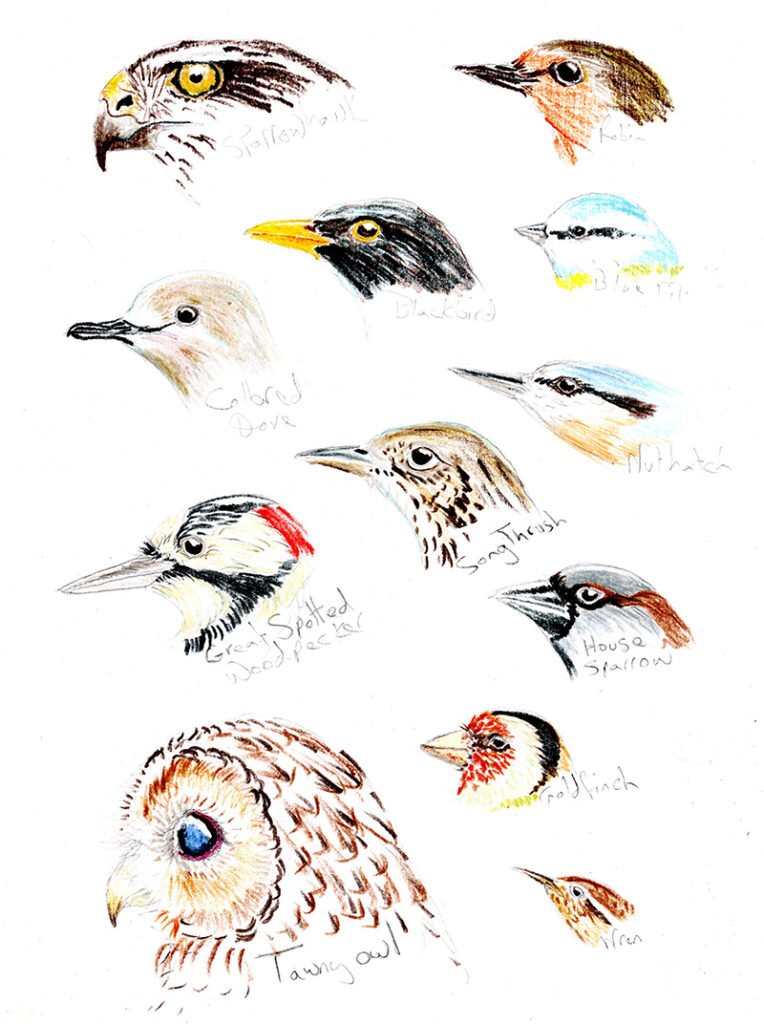Nature on your doorstep
As everything is a little topsy turvy right now and we’re all confined to our homes once again. We thought it would be fun to take a look at the nature on our doorstep. Where better to start than garden birds?
We can all look out of our window and spy the birds going about their business. I’m sure you’ve noticed how much more active they’ve become since the winter solstice, as the days are beginning to get longer.
Garden Birds through the kitchen window
We recently placed some bird feeders outside our kitchen window, we’re spending lots more time at the kitchen table! So far we’ve had some exciting visitors, Robins, Blue-tits, Great-tits, Sparrows, Nut Hatches and a once a day flurry of Long-Tailed-Tits.

We’re hoping to attract gold finches, we know they’re in the neighbourhood. We’ve ordered a new seed feeder and some nigella seed as that’s apparently one of their favourites. It got us thinking about the particular foods different birds eat, and how their beak shape affects that.
Beaks and breakfast (or lunch!)
Ian has put together a table of the birds you’re most likely to see in your garden, their beak shape and the food they eat.
| Species | Beak Shape | Purpose | Wild food | Garden Food |
| House Sparrow Best Garden Feature: Accessible cavities in and under eaves | Short forceps/seed cracker combo. Generalist primarily for seeds | None specialist seed eater also used for insects and other food | Seeds and insects (for nestlings) | All foods Will hang or stand on flat surfaces. |
| Blue Tit Best Garden Feature: Nest boxes (Great for most birds) | Short forceps – Generalist for small insects | None specialist insect eater also used for seeds and other food | Insects (especially aphids), spiders and other invertebrates. | All foods (especially peanuts and suet)Prefers to hang. |
| Robin Best Garden Feature: Dense shrubs and open spaces combined | Medium length Forceps – generalist for medium sized invertebrates | Picking up insects and worms | Spring Summer: Small, mostly soft bodied, ground-living invertebrates: insects, spiders, worms, small snails as well as tadpoles and small fish. Autumn to Early Spring: Soft fruits, berries and small seeds as well as invertebrates. | Most foods (including mealworms, peanuts and fatty foods) prefers a flat surface to stand on (table or floor but will hang sometimes). |
| Goldfinch Best Garden Feature: Teasel and other tall seedy plants | Forceps/mini-nutcracker comb – Specialist for small hard seeds | Picking small seeds out of teasel and thistle heads etc and cracking them | Thistle, Teasel, burdock, knapweed, birch, alder, some insects in summer (especially to feed young) Some seeds and fruit | Sunflower hearts, niger-seed teasel heads, tall ‘weeds’ |
| Blackbird Best Garden Feature: Ivy and bramble patch | Forceps | Picking up invertebrates and berries | Fruit and berries when in season, otherwise worms, caterpillars and other invertebrates as well as tadpoles | Fruit (including currants and raisins) and suet. Preferably on the ground or a low flat surface. |
| Song Thrush Best Garden Feature: Compost heap and wormery | Forceps | Picking up snail shells, earthworms, berries and seeds | Snails, worms, insects, fruit, berries and seeds | Most bird foods, especially, currants and raisins and apples as far from human/cat/dog disturbance as possible and close to cover (e.g. shrubs). |
| Nuthatch Best Garden Feature: Log-pile, standing stumps and your bird feeder | Awl shaped, used like and adze. Generalist feeder specialised for using cracks and crevices and opening tough food | Cracking seeds and nuts and hammering such food into crevices and retrieving it. | Autumn/winter: Hazel nuts, beech mast, acornsSpring/summer Insects and spiders, especially beetles, earwigs and caterpillars | Peanuts, sunflower seeds and fatty foods |
| Pigeons/doves Best Garden Feature: Flat table birdfeeder | Forceps | Picking buds, berries, fruit and larger seeds | Leaves, berries, seeds plus some insects | Grain and grain derived products (bread, cake) on a flat surface (bird table) or the ground. |
| Great Spotted Woodpecker Best Garden Feature: Trees (where appropriate) Rowan would suit song thrush and grows quickly to a manageable height | Hammer-drill or adze | Pecking holes in wood | Many invertebrates as well as small mammals and nestling birds plus some seeds, fruit and fungi | Nuts, suet and other geneal bird foods preferably hanging or wedged into cracks in a stump or post. |
| Tawny Owl Best Garden Feature: Poles for perching | Slightly hooked. Owls can tear food (they do this to feed young nestlings) but have a very large gape and swallow most prey whole | Stabbing, tearing and plucking | Mostly small mammals but also small birds (especially fledglings, frogs and invertebrates (especially worms) | Grassy patches and refuges for mice and voles. |
| Sparrow hawk Best Garden Feature: A busy bird table out in the open.Poles for perching | Hooked | Stabbing and tearing muscle | Mostly small birds up to the size of pigeons but also small mammals and insects | |
| Wren Our commonest bird but quite shy of bird tables and feeders Best Garden Feature: A little wilderness with some shelter to nest | Forceps | Picking up or stabbing, small soft invertebrates | Insects, spiders, small worms, tadpoles. Occasional small seeds | Mealworms, other insects and fatty foods (especially in cold weather.) |

Enjoy the birds in your garden!
We have a garden bird colouring sheet available which is free to download.
You can grab a copy here


